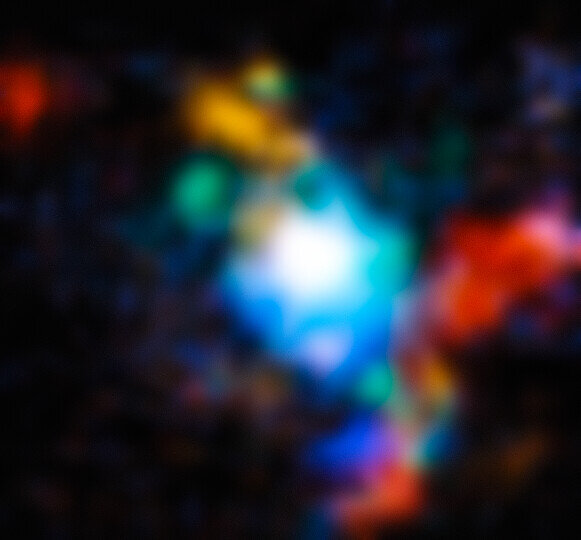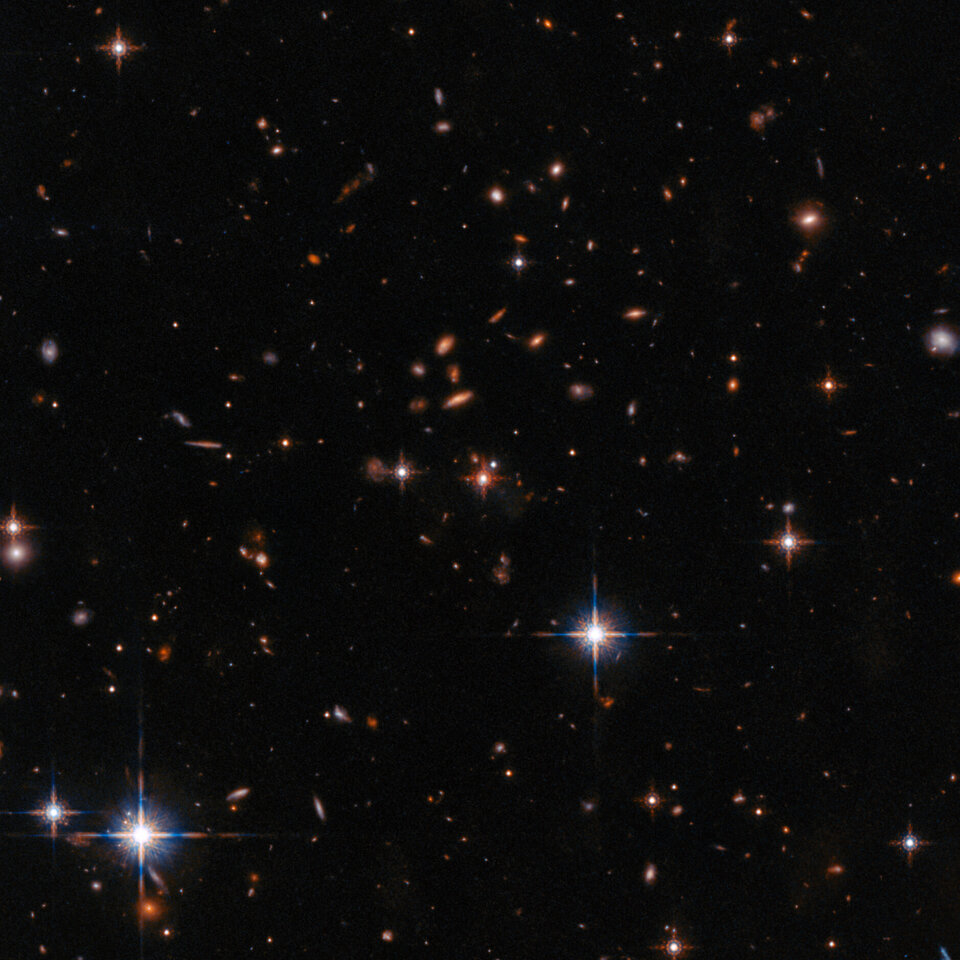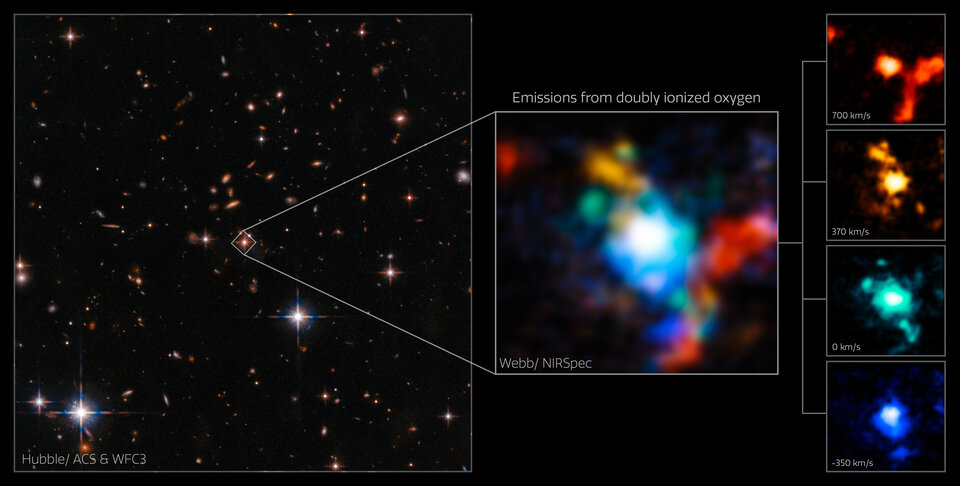25.10.2022
James Webb Space Telescope spies galaxies merging around 'monster' black hole

Astronomers have discovered a cluster of galaxies merging around a rare red quasar, a "monster" supermassive black hole that is greedily feeding on gas and other material.
An international team of scientists made the surprising discovery as they were using the James Webb Space Telescope (JWST) to stare billions of years back in time. The finding represents an opportunity to observe how early galaxiesmerged forming the universe as we see it today. The blindingly bright quasar and extremely red quasar, known as SDSS J165202.64+172852.3, is about 11.5 billion years old and one of the most powerful ever seen from a such tremendous distance away, according to the researchers, who describe it as a black hole in formation.
"We think something dramatic is about to happen in these systems," Andrey Vayner, research co-author and an astrophysicist at Johns Hopkins University in Maryland, said in a statement. "The galaxy is at this perfect moment in its lifetime, about to transform and look entirely different in a few billion years."
Earlier observations of this region of space using the Hubble Space Telescopeand the Gemini-North telescope in Hawaii had revealed the quasar and hinted at a galaxy in a transitional phase. But it was only further observation with JWST that revealed not one but at least three galaxies all swirling around the quasar.
"With previous images, we thought we saw hints that the galaxy was possibly interacting with other galaxies on the path to a merger because their shapes get distorted in the process and we thought we maybe saw that," Nadia L. Zakamska, co-principal investigator and Johns Hopkins astrophysicist, said in the same statement. "But after we got the JWST data, I was like, 'I have no idea what we're even looking at here, what is all this stuff!' We spent several weeks just staring and staring at these images."
The JWST images of the region also showed that the three galaxies are moving incredibly quickly, suggesting the presence of a tremendous mass, which leads the team to think this could be the densest area of galaxy formation ever seen in the early universe.
"Even a dense knot of dark matter isn't sufficient to explain it," Dominika Wylezalek, an astronomer at Heidelberg University in Germany who led the research, said in a Webb statement. "We think we could be seeing a region where two massive halos of dark matter are merging together."
Even Vayner, who had imagined observing this quasar with JWST as much as a decade ago, was shocked that the space telescope, which only started sending science images back to Earth in July, has produced observations of the region with such clarity.
"It really will transform our understanding of this object," he added.
The team will now attempt to follow up this observation of this unexpected galaxy cluster hoping to decipher the secrets of how such dense groupings of galaxies formed in the early universe and how this process is affected by the supermassive black holes that lurk at their hearts.
"What you see here is only a small subset of what's in the data set," Zakamska said.
"There's just too much going on here so we first highlighted what really is the biggest surprise," she said. "Every blob here is a baby galaxy merging into this mommy galaxy and the colors are different velocities and the whole thing is moving in an extremely complicated way. We can now start to untangle the motions."
The team's research is being published in the Astrophysical Journal Letters and a preprint is also available on the paper repository arXiv.
Quelle: SC
+++
Webb uncovers dense cosmic knot in the early Universe

Astronomers looking into the early Universe have made a surprising discovery using the NASA/ESA/CSA James Webb Space Telescope. Webb’s spectroscopic capabilities, combined with its infrared sensitivity, have uncovered a cluster of massive galaxies in the process of formation around an extremely red quasar. The result will expand our understanding of how galaxies in the early Universe coalesced into the cosmic web we see today.
The quasar in question, SDSS J165202.64+172852.3, is an “extremely red” quasar that exists in the very early Universe, 11.5 billion years ago. Quasars are a rare, incredibly luminous type of active galactic nucleus (AGN). This quasar is one of the most powerful known galactic nuclei that’s been seen at such an extreme distance. Astronomers had speculated that the quasar’s extreme emission could cause a “galactic wind”, pushing free gas out of its host galaxy and possibly greatly influencing future star formation there.
An AGN is a compact region at the centre of a galaxy, which is emitting enough electromagnetic radiation to outshine all the galaxy’s stars. AGNs, including quasars, are powered by gas falling into a supermassive black hole at the centre of their galaxy. They typically emit vast amounts of light across all wavelengths, but this galactic core is a member of an unusually red class. In addition to its intrinsic red colour, the galaxy’s light has been further redshifted by its vast distance. That made Webb, having unparalleled sensitivity in infrared wavelengths, perfectly suited to examine the galaxy in detail.
To investigate the movement of the gas, dust and stellar material in the galaxy, the team used the telescope’s Near Infrared Spectrograph (NIRSpec). This powerful instrument can simultaneously gather spectra across the telescope’s whole field of view, instead of just from one point at a time – a technique known as integral field unit (IFU) spectroscopy. This enabled them to simultaneously examine the quasar, its galaxy and the wider surroundings.

Spectroscopy was critical to understand the movement of the various outflows and winds surrounding the quasar. The motions of the gases affect the light that they emit and reflect, causing it to be red- or blueshifted in proportion to their speed and direction [1]. The team was able to see and characterise this movement by tracking ionised oxygen in the NIRSpec spectra. The IFU observations were especially useful, with the team taking full advantage of the ability to collect spectra from a wide area around the quasar itself.

Previous studies by, among others, the NASA/ESA Hubble Space Telescope and the Near-Infrared Integral Field Spectrometer instrument on the Gemini-North telescope called attention to the quasar’s powerful outflows, and astronomers had speculated that its host galaxy could be merging with some unseen partner. But the team was not expecting Webb’s NIRSpec data to clearly indicate that they were not just looking at one galaxy, but at least three more swirling around it. Thanks to the IFU spectra over a broad area, the motions of all this surrounding material could be mapped, resulting in the conclusion that SDSS J165202.64+172852.3 was in fact part of a dense knot of galaxy formation.
"There are few galaxy protoclusters known at this early time. It’s hard to find them, and very few have had time to form since the Big Bang,” said astronomer Dominika Wylezalek of Heidelberg University in Germany, who led the study into this quasar. “This may eventually help us understand how galaxies in dense environments evolve… It’s an exciting result.”
Using the IFU observations from NIRSpec, the team was able to confirm three galactic companions to this quasar and show how they are connected. Archive data from Hubble hints that there may be even more. Images from Hubble’s Wide Field Camera 3 had shown extended material surrounding the quasar and its galaxy, prompting its selection for this study into its outflow and the effects on its host galaxy. Now, the team suspects they could have been looking at the core of a whole cluster of galaxies – only now revealed by Webb’s crisp imaging.
"Our first look at the data quickly revealed clear signs of major interactions between the neighbouring galaxies,” shared team member Andrey Vayner of Johns Hopkins University in Baltimore, USA. “The sensitivity of the NIRSpec instrument was immediately apparent, and it was clear to me that we are in a new era of infrared spectroscopy."
The three confirmed galaxies are orbiting each other at incredibly high speeds, an indication that a great deal of mass is present. When combined with how closely they are packed into the region around this quasar, the team believes this marks one of the densest known areas of galaxy formation in the early Universe.“Even a dense knot of dark matter isn’t sufficient to explain it,” Wylezalek says. “We think we could be seeing a region where two massive halos of dark matter are merging together.”
The study conducted by Wylezalek’s team is part of Webb’s investigations into the early Universe. With its unprecedented ability to look back in time, the telescope is already being used to investigate how the first galaxies were formed and evolved, and how black holes formed and influenced the structure of the Universe. The team is planning follow-up observations into this unexpected galaxy proto-cluster, and hope to use it to understand how dense, chaotic galaxy clusters like this one form, and how it’s affected by the active, supermassive black hole at its heart.
They aim first to return to the question of galactic winds and quasar feedback. Quasars have long been suspected as the culprit of reduced star formation in their host galaxies by this feedback mechanism, but firm evidence to link the two has been difficult to come by. The present observations are just the first in a set which will study three quasars with Webb, each at different times in the past of the Universe.
“To disentangle the incredibly bright light of a distant quasar from the much dimmer host and its companions is almost impossible from the ground. Uncovering the details of the galactic winds that may produce feedback is even more challenging,” shared team member David Rupke of Rhodes College in Memphis, USA. “Now with Webb, we can already see that’s changing.”
This research was completed as part of Webb’s Early Release Science (ERS) Programs. These observations are taking place during the first 5 months of Webb science operations. The Webb observations that yielded this result were taken from the ERS program #1335.
Notes
[1] When light waves are emitted by a moving source, they can be squashed together or stretched apart from our perspective here on Earth, depending on the direction the source is moving. If a light source moves away from us, the stretching shifts its light into redder wavelengths, and if the source is moving towards us its light becomes bluer. This is known as the Doppler effect, analogous to how sound waves are shifted when emitted by a moving vehicle such as an ambulance. Light waves can also be redshifted because the space between it and us is expanding - so-called cosmological redshift.
Quelle: ESA
----
Update: 26.10.2022
.
Webb explores a pair of merging galaxies

Hubble

Webb
Here, the Webb Picture of the Month of merging galaxies IC 1623 A and B is juxtaposed with a new image from the NASA/ESA Hubble Space Telescope. This image on the right, combining data from Hubble’s ACS and WFC3 instruments, gives a familiar visible-light view of these colliding galaxies, where the centres of the individual galaxies are much more obscured by dark dust. Meanwhile, in Webb’s combined MIRI and NIRCam view of the galaxies on the left, the gas being used as fuel by the stellar nurseries is especially apparent. Webb’s ability to pierce the gaseous veil obscuring the bright galactic cores also causes prominent diffraction spikes to appear.
The image on the left from the NASA/ESA/CSA James Webb Space Telescope depicts IC 1623, an entwined pair of interacting galaxies which lies around 270 million light-years from Earth in the constellation Cetus. The two galaxies in IC 1623 are plunging headlong into one another in a process known as a galaxy merger. Their collision has ignited a frenzied spate of star formation known as a starburst, creating new stars at a rate more than twenty times that of the Milky Way galaxy.
This interacting galaxy system is particularly bright at infrared wavelengths, making it a perfect proving ground for Webb’s ability to study luminous galaxies. A team of astronomers captured IC 1623 across the infrared portions of the electromagnetic spectrum using a trio of Webb’s cutting-edge scientific instruments: MIRI, NIRSpec, and NIRCam. In so doing, they provided an abundance of data that will allow the astronomical community at large to fully explore how Webb’s unprecedented capabilities will help to unravel the complex interactions in galactic ecosystems. These observations are also accompanied by data from other observatories, including the NASA/ESA Hubble Space Telescope, and will help set the stage for future observations of galactic systems with Webb.
The merger of these two galaxies has long been of interest to astronomers, and has previously been imaged by Hubble and by other space telescopes. The ongoing, extreme starburst causes intense infrared emission, and the merging galaxies may well be in the process of forming a supermassive black hole. A thick band of dust has blocked these valuable insights from the view of telescopes like Hubble. However, Webb’s infrared sensitivity and its impressive resolution at those wavelengths allows it to see past the dust and has resulted in the spectacular image above, a combination of MIRI and NIRCam imagery.
The luminous core of the galaxy merger turns out to be both very bright and highly compact, so much so that Webb’s diffraction spikes appear atop the galaxy in this image. The 8-pronged, snowflake-like diffraction spikes are created by the interaction of starlight with the physical structure of the telescope. The spiky quality of Webb’s observations is particularly noticeable in images containing bright stars, such as Webb’s first deep field image.
MIRI was contributed by ESA and NASA, with the instrument designed and built by a consortium of nationally funded European Institutes (The MIRI European Consortium) in partnership with JPL and the University of Arizona.
NIRSpec was built for the European Space Agency (ESA) by a consortium of European companies led by Airbus Defence and Space (ADS) with NASA’s Goddard Space Flight Center providing its detector and micro-shutter subsystems.
Quelle: ESA
----
Update: 28.10.2022
.
New James Webb Space Telescope photos show a massive galaxy cluster bending light






